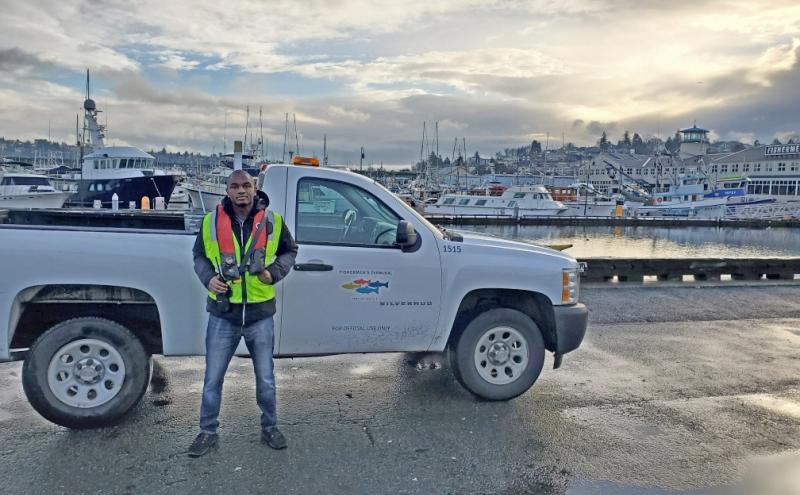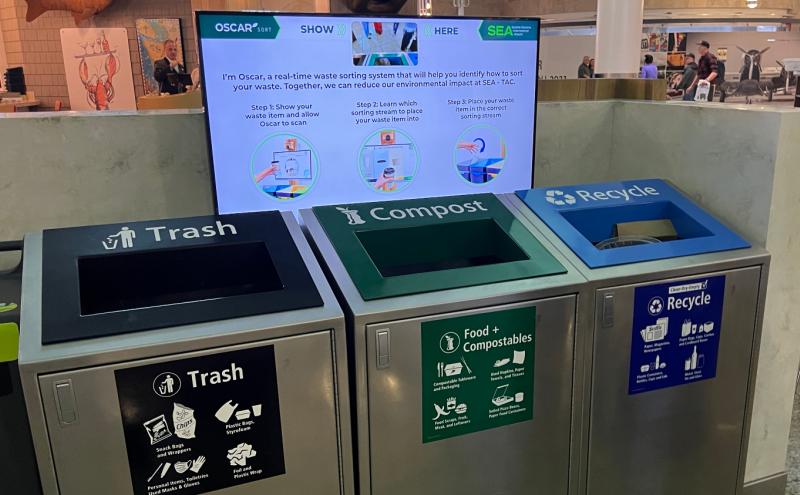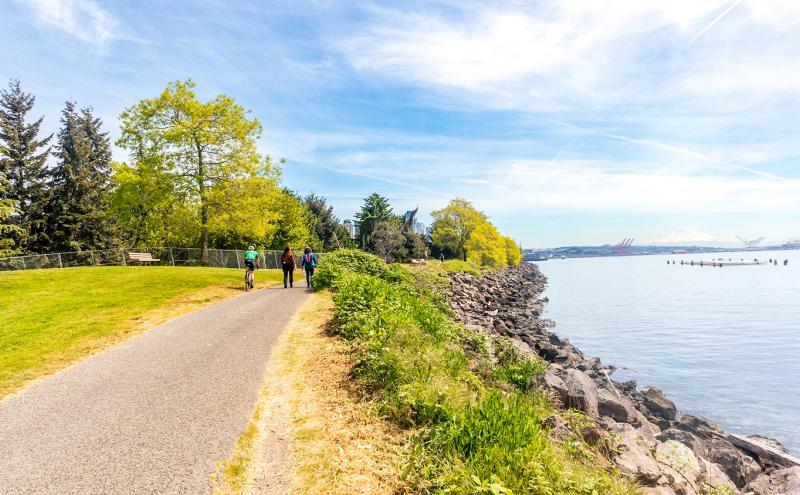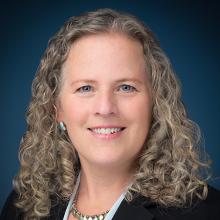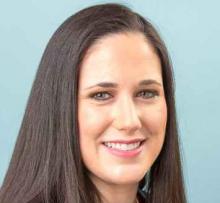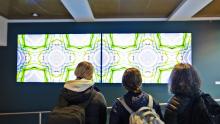
By Isabella Newcomer, Environment and Sustainability Intern
When I tell people that I have a summer internship with the Port of Seattle’s Environment and Sustainability Department at Seattle-Tacoma International Airport (SEA), their initial reactions are often confusion, or even disbelief that a major airport has a whole department focused on environmental stewardship. My time with the Port of Seattle supporting waste reduction and outreach programs has not only given me my first professional experience in my chosen field of study (I’m a rising junior at Scripps College studying Environmental Analysis) but also a unique lens into the behind-the-scenes operations of an airport. If you’re anything like me, you’ve looked out the window at your gate while waiting to board a flight and wondered, “What is that pipe for? What does that button do? Where do my bags go after I drop them off at that scary-looking conveyer belt?”
I can confirm that seeing the underground tunnels, with miles of conveyer belts handling all the luggage was mind-boggling! Even more rewarding than exploring secret tunnels, however, was discovering just how many of the airport’s mysterious doors, pipes, and buttons are actually key components in SEA’s efforts to blaze a trail toward more sustainable aviation.
Secret doors: SEA’s Food Donation Program
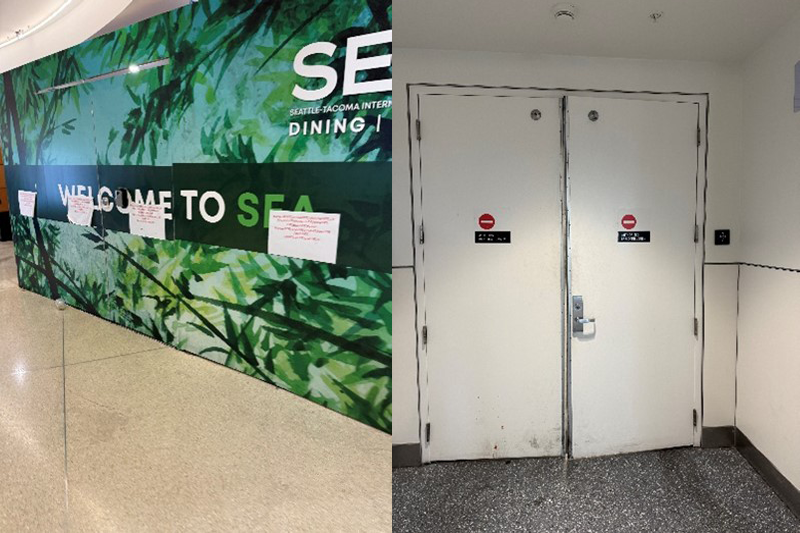
As you walk through the airport, you’ll spot many construction barricades and doors marked with red signs noting “authorized personnel only.” I, like many curious travelers, have always wondered what could lie behind those doors. Is it a spooky hidden labyrinth? Or maybe a spa for pilots to relax in between flights? Through my internship I have gotten the chance to go behind at least two of these doors, and I’m excited to share that these two “secret doors” pictured here are home to SEA’s food donation program. Through this program, airport dining and retail tenants donated over 26,000 meals to local food banks last year!
The Food Donation Program has been around since 2006, and it is one of the many ways that SEA reduces waste and supports the surrounding community. Currently the program is contained in one room located before security. Behind this mysterious green construction barricade is a wall of refrigerators and crates of food that are packed up by volunteers and sent to nonprofits such as the Des Moines Area Food Bank.
As the program continues to expand, additional space will be added after security in the North Satellite to make it easier for tenants to donate food and further streamline the process.
P.S. Wondering what happens to your conditioner bottle that didn’t make it through a security screening? Through Donation Drop @ SEA, shampoo, conditioner, and other products that don’t meet TSA security checkpoint requirements are placed into donation crates instead of trash bins and sent to the Des Moines Food Bank. Donation Drop @ SEA is now donating around 200 pounds. of unused personal hygiene products weekly!
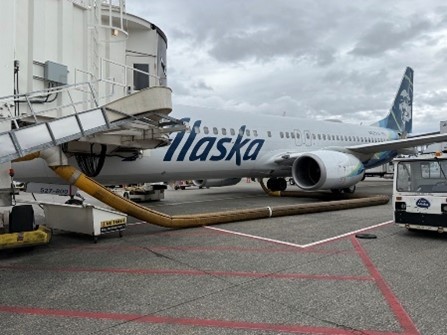
Mysterious pipes: Pre-Conditioned Air
At the airport there is certainly no shortage of pipes and buttons that all clearly serve super important (and super mysterious) functions. Pictured to the left and below are some of the inner workings of SEA’s Pre-Conditioned Air system (PC Air), a sustainability project that reduces fuel costs for airlines, improves air quality, reduces noise pollution, and increases energy efficiency throughout SEA Airport.
So what is PC Air exactly, and how could this chunky yellow hose possibly help save the planet? Think of it this way. Have you ever been on a road trip and needed to make a rest stop? Because of the scorching midsummer heat, you leave the car running to enjoy the air conditioning while your little sister takes her time choosing the perfect snack from the vending machine. By the time you get going again, you realize you’ve been using up precious fuel just to keep the car cool, and you’re still 100 miles from your destination. But what if there was a service that cooled your car for you while it was parked, and you could relish the benefits of air conditioning without the extra emissions? This is what PC Air does for the planes parked at SEA’s gates.
PC Air heats or cools aircraft during boarding and deplaning through a centralized plant which delivers hot and cold fluids through miles of pipes to 83 gates. At each gate, a unit then pre-conditions warm or cool air which is blown into the aircraft, allowing aircraft to shut down their auxiliary power units (APU’s) which would otherwise be emitting carbon dioxide and adding to fuel costs.
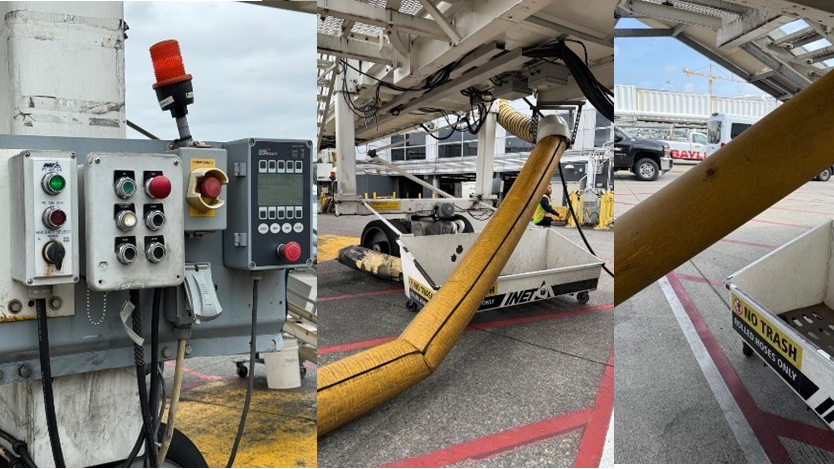
However, this system has seen some wear and tear since it was installed about 13 years ago —and that’s where the mechanical engineering interns and I come in. Like all machines, PC Air has many parts that sometimes stop working, and unclear communication leads to delays in getting PC Air back up and running as it should be, leading aircraft to resort back to APUs for their air conditioning. The past few weeks, the other interns and I have been working on a PC Air system audit, where we’ve identified common problems (like the hose with a gaping hole pictured above) and interviewed ramp workers to learn more about what challenges they face in terms of reporting maintenance issues. We took these pictures on one of these airfield walks, and it’s been incredible to have this chance to learn about airport operations and think about ways to make it both smoother and more sustainable.
High-tech trash: Oscar, compactors, and trash maps 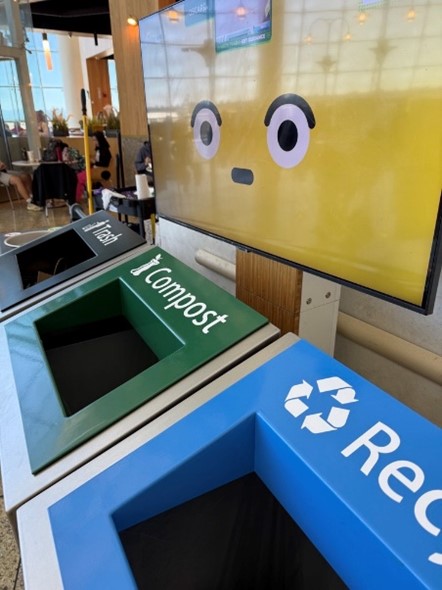
As the waste reduction intern, I can’t write this blog without talking a little trash — that is, AI-sorted, high-tech trash. SEA has four “Oscar” waste sorting assistants positioned throughout the terminal — located in the Central Terminal, North Concourse, South Concourse, and C Concourse. If you walk up to one of these Oscars and hold a piece of waste up to the camera, the AI will scan the object, identify it, and tell you how to correctly dispose of it. For example, if you hold up a used to-go box from your favorite airport restaurant, Oscar will tell you to put it in the compost!11 Yes, your to-go box is compostable! SEA’s reliance on single use plastics has been significantly reduced by a new requirement to use reusable dishes and compostable to-go packaging for all dining and retail tenants.
I took this picture on one of my routine Oscar checkups this summer; part of my job was to make sure all four units were working properly and perform any quick fixes when needed (this one was having issues with camera angle). And for those who were wondering, yes, Oscar is in fact named after the character from Sesame Street (though this robot’s bright yellow smiley face is far from grouchy, and actually has quite a cheerful disposition as far as robots go).
While having only four Oscars creates a minimal impact in terms of actual waste diversion, they still provide us with useful information about traveler waste sorting. For example, Oscar reports show that napkins have consistently been incorrectly sorted, ending up in trash and recycle bins instead of compost containers. This data allows us to think about ways to improve public education and outreach about waste sorting at SEA. So now Oscar displays focused messages about proper napkin sorting into compost.
If you thought Oscar was the only high-tech trash bin at the airport, think again! Going behind the scenes once more, tenants’ dumpsters have their own technological twist to support waste diversion. These containers are accessed by a “pay as you throw” mechanism, meaning tenants are charged more for using the trash compactors than recycling or composting. The swipe system controls access and also tracks how much each compactor is being used, which is super useful for getting a big picture understanding of the airport’s waste streams and sources. And speaking of big picture airport waste streams, in case you were wondering how many waste receptacles there are in the public areas of the airport, there are currently 497. I counted them all for my department’s yearly inventory, which includes an interactive digital map that displays information about bin condition, waste streams, and signage.
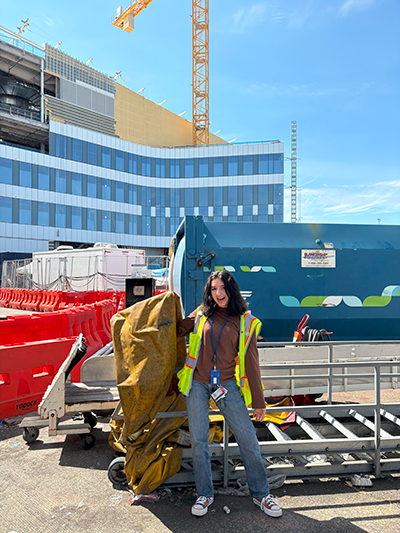 As you can see, technology and trash work together seamlessly in SEA’s waste diversion programs, supporting the many initiatives that ensure as much as possible gets sent to recycling and compost instead of landfills. Last year, 49% (4,481 tons) of waste from SEA terminals was diverted from landfills — a huge step towards the Port’s goal of 60% municipal solid waste diversion!
As you can see, technology and trash work together seamlessly in SEA’s waste diversion programs, supporting the many initiatives that ensure as much as possible gets sent to recycling and compost instead of landfills. Last year, 49% (4,481 tons) of waste from SEA terminals was diverted from landfills — a huge step towards the Port’s goal of 60% municipal solid waste diversion!
Wrapping up
As an environmental studies student with a lifelong fascination for finding out the behind the scenes of how things work, this internship has been absolutely incredible. In a short span of two and a half months, interning at the Port of Seattle has taught me a lot about what it means to work at a public agency. Every employee at the Port is a dedicated public servant with the goal of creating the best travel experience possible for travelers, which encompasses everything from customer service, efficiency, and sustainability. The Port is a reflection of what the public values and desires, and in Seattle we definitely care about being good stewards of our gorgeous Pacific Northwest natural resources. Who doesn’t love our region’s signature salmon streams or a view of Mt. Rainier on the Link light rail to SEA? With this perspective, it’s not actually that hard to believe that sustainability is an integral part of SEA Airport operations (even though it still might be hard to believe that SEA is home to 12 bee colonies. The beehives, managed by Sunflower Bee Company, have been in place for over 10 years!)
Subscribe to Evergreen for environmental news from the Port and SEA Airport


